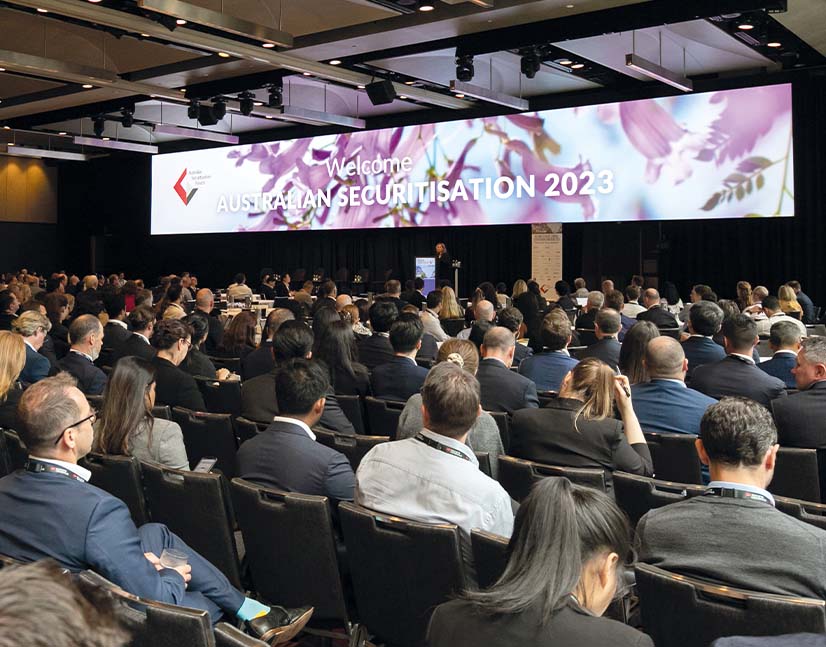
Securitisation investors fret noncall risk
The focus of commentary in the Australian securitisation market has tended to be on borrowers’ ability to keep making loan payments as higher interest rates cut deeper into household balance sheets. But investors are also paying close attention to technical factors in the structured finance asset class, including the potential for some deals not to be called at the earliest opportunity.
Dan O'Leary Deputy Editor KANGANEWS
At the heart of the call risk issue is the rapid reversion of securitisation deal margin between the halcyon days of 2021 and the more challenged environment of 2022. Spread widening last year, that has lingered into the opening weeks of 2023, has made residential mortgage-backed securities (RMBS) funding a more expensive proposition for lenders.
The question is whether some issuers will not be able to refinance their lending books economically using public RMBS and, if so, whether they will have alternative funding options sufficient to allow them to call outstanding notes even without like-for-like refinancing.
Paulina Ting, senior portfolio manager at CIP Asset Management in Sydney, believes the funding margin on nonbank prime RMBS has moved wider than what some lenders are making on underlying mortgages. She says some 2021transactions in particular will be expensive for issuers to redeem unless mortgage rates increase meaningfully above the cash rate. “We are concerned that there is a mismatch between the level of mortgage rates and securitisation funding costs,” Ting confirms.
She notes that prime RBMS have historically had a very tight margin between mortgage rates and funding cost – a situation that exposes this market segment to stress in circumstances like those that began last year, in which rising funding cost combines with a squeeze on margin driven by higher cash rates.
“We see some interest on prime RMBS mezzanine notes being subordinated below losses post call because there is not enough income on the mortgages to pay interest under rating agency stresses,” Ting adds. “When these kinds of structures combine with these market conditions, the economic incentive to call a transaction that was issued at the tights of the market in 2021 or early 2022 may not be there.”
“For good issuers that require increased warehouse capacity, the bank potentially has the ability and willingness to increase if we have good relationships, the business model demonstrates resilience and credit quality is as expected.”
Button TextPANDEMIC COHORT
Market users are quick to point out that call risk may not be an imminent threat. The key point here is that it is primarily the cohort of deals priced in ultra-competitive pandemic-era market conditions that will experience the most dramatic pricing reversion.
Margins on the senior term tranches of Australian nonbank prime RMBS issued in 2020-21 fell as low as the 70s basis points over BBSW while the same type of issuance was paying more than twice that level by late 2022. The first large prime RMBS of 2023, Columbus Capital’s Triton 2023-1, offered a margin of 140 basis points over BBSW on its class A notes.
Funding economics only adds to the reasons for scrutiny of RMBS deals struck in the pandemic era. Most market commentary has focused on the credit characteristics of these loan pools, specifically the fact that borrowers who took out loans at ultra-low fixed rates in the era of wholesale debt margins anchored by yield-curve control and the term funding facility are gradually refinancing in a much less appealing credit market as those fixed terms expire.
A declining housing market and potential for increased arrears in securitisation pools are a general source of scrutiny. Ting adds that it is “not helping” that a lot of the underlying loans are potentially now underwater on a loan-to-value ratio basis. “We are more hesitant on these transactions,” she concludes.
However, while investors typically expect issuers to call RMBS notes at the earliest opportunity, that moment is likely not imminent for the most at-risk pools. Australian nonbank RMBS is typically structured with a 3-5 year date-based call or a 20 per cent clean-up option triggered when 80 per cent of the issued notes have amortised. With eyes most closely focused on the pandemic-era vintage of new issuance, there should be at least some window for capital market spreads to improve for issuers before the day of reckoning.
“This is potentially an issue in 2024, but it is something we are monitoring and thinking about now,” Ting tells KangaNews. “Issuers will call where they can, but do they have the support of their banks to increase warehouse facility limits when the collateral clearly cannot be reissued into a new public deal?”
“Yes, funding costs have increased and the uncertainty about funding volume at the same capacity has been questionable – particularly in the back end of 2022. But this has not altered our funding strategy. We need an active and widening group of investors, and we are working to make sure this happens.”
Button TextISSUERS IN FOCUS
The question of bank support is particularly important and it provides one of the two areas of strong guidance about the issuer profile investors are watching most closely. In general, the buy side is much less concerned about the prospects for larger, longstanding players in the nonbank sector.
Although their books are bigger and they are more regularly active in capital markets – and thus exposed to new issuance pricing – they have experience managing through periods of stress that in many cases goes back to the global financial crisis.
Perhaps even more importantly, they typically have wider, deeper and longer-established banking relationships and – in many cases – access to alternative sources of funding including their own retained earnings. This should give them a greater buffer against one-for-one refinancing risk in capital markets.
Bigger names in the nonbank sector may have to dial back their origination during periods in which the funding-lending pipeline makes them uncompetitive, but investors tend to believe they will not struggle to make RMBS calls barring a major, unforeseen worsening of new issuance markets.
For Dylan Bourke, managing director and portfolio manager at Kapstream Capital in Sydney, issuer strength can influence whether deals are called even more than pool performance.
Bourke says call risk could be building in parts of the credit market where less established nonbank issuers are competing directly with major banks. Fintech lenders, for instance, have also tended to find things harder due to the rising cash rate and competition from established banks. “It is hard for newcomers to get equity now and the cost of equity means if these businesses are not profitable it may put pressure on them. If they do not survive this period, obviously they are not going to call.”
In this context, senior debt is only part of the issue. Mezzanine support was harder to find in 2022 across primary securitisation issuance and market users say newer entrants felt the lack of appetite more acutely. Investors say smaller and less well-established players with reduced access to equity or senior and subordinated debt to fund RMBS calls will be in the front line of any forthcoming refinancing issues.
Bourke says nonbank lenders that are not yet profitable will be most likely to experience increasing stress. As well as likely having a smaller range of banking relationships and access to alternative capital, the idea of simply pulling back from origination for a protracted period is likely to be unpalatable to any business with a strategy of scaling up to profitability.
Bourke also raises the second guidance point on the type of issuer that will be under most scrutiny: the type of lending business written. While nonconforming mortgages and nonmortgage lending may carry higher credit risk, it also generally has a higher margin – which should provide some degree of buffer against higher capital market funding cost.
On the other hand, Bourke adds: “Prime mortgages have very low net interest margins so breaking even is much harder. The question then becomes whether the originator can get through this period. This will separate some lenders out – it will not surprise me if one or two fail.”
There have already been some shots across the bow, albeit not from businesses that had accessed the public capital market. Nano Digital Loan’s decision to sell its loan book to AMP Bank illustrates how newer lenders that could have been future securitisation issuers may start considering their exit strategies. Nano was part of a cohort of neobanks that cropped up over the last few years, fuelled by low interest rates and the goal of disrupting traditional banking. Others, such as Xinja and 86 400, have folded or been acquired.
“Prime mortgages have very low net interest margins so breaking even is much harder. The question then becomes whether the originator can get through this period. This will separate some lenders out – it will not surprise me if one or two fail.”
Button TextFUNDING CONTINGENCY
On the other hand, nonbank issuers – even those that have at least some of the characteristics investors appear to be focused on – say their funding plans were drawn up in a way that takes into account more problematic capital market issuance conditions.
For instance, Athena Home Loans priced its debut RMBS transaction as a private placement in October 2021, for A$300 million, and followed with a A$400 million public securitisation the following year. The A1-L notes on the 2022 deal priced at 160 basis points over BBSW – as much as 70 basis points wider than what market users say was the margin on the debut deal, on which pricing was not publicly disclosed. The 2021 deal’s call option is scheduled for 11 October 2023 while the 2022 transaction’s first call will occur in March 2026.
Jason Finlay, treasurer at Athena in Sydney, says the issuer is committed to calling its transactions. “There is a bigger business imperative and other priorities going on than just a basis point count,” he notes. “It is assumed that calling a deal is factored into the funding budget. This is on our radar for our liquidity planning for the year.”
The issuer is well aware of the impact of failing to call. “We aim to be a long-term participant in the market so we are not making short-term decisions to save margin,” Finlay comments, adding that Athena has access to a number of funding sources of which public RMBS is just one. Other options include private placements and whole loan sales.
Meanwhile, Satish Chand, chief executive at Loanworks in Sydney, says the issuer’s strategy of financing mortgages through its warehouse and then terming out into public markets has not changed.
Loanworks issued its first two RMBS deals in 2021. Both deals are collateralised with prime residential mortgages and have optional call dates scheduled for 2026. The latest deal’s senior notes priced at 95 basis points over BBSW.
“Yes, funding costs have increased and the uncertainty about funding volume at the same capacity has been questionable – particularly in the back end of 2022. But this has not altered our funding strategy,” Chand explains. “We need an active and widening group of investors, and we are working to make sure this happens.”
Chand acknowledges that warehouse costs have increased and that this adds pressure to the issuer’s operating structure, but this is only one aspect of the business’s overall costs.
Other market users are keen to emphasise that funding markets are not closed even if they are more costly for issuers. Refinancing economics may be challenging but this is not the same as issuers – even relative newcomers – not having access to capital.
Rob Camilleri, founder and head of structured credit at Realm Investment House in Melbourne, says: “Liquidity in the system would need to be in dire straits, which would mean banks having problems funding themselves or selectively not extending wholesale funding. A lot of ducks would have to line up in a row for banks not to extend funding, but they have increased their wholesale funding costs by about 20-30 basis points – which means they are looking for more headroom.”
Camilleri agrees that younger issuers would likely be on the front line of any withdrawal of bank liquidity as “there would likely by some preferential treatment” for established names. However, he adds: “The banks are coming to the party by providing headroom where public issuance, for certain parts of the market, does not make any sense. Issuers will likely rely on more private funding, though the cost of this funding will go up, too.”
The good news, according to Sarah Samson, Melbourne-based global head of securitisation origination at National Australia Bank, is that warehouse costs had likely peaked by early 2023 and should fall over the course of the year despite expected periods of volatility.
“Capital markets have improved significantly from the very tough times of 2022,” Samson notes. “RMBS pricing has tightened and the banks are also issuing at tighter levels across a number of formats – there are many components that go into funding costs.”
Collateral that returns to warehouses is typically well-seasoned, high-quality mortgages, Samson continues. “We are talking about five years or longer aged mortgages and they are typically variable rate in the nonbank sector,” she says. “These lenders have been passing on rate increases. Yes, they are taking back what would have been – depending on the time of issuance – much cheaper funding and putting it into more expensive warehousing. But the variable rate will reduce the shock.”
For Chand, the ability to maintain net interest margin (NIM) is a more important cost factor. “We either pass a full rate rise on across the spectrum of our products, or we are more selective, or we simply look to not originate as much to help maintain NIM and keep cost under control,” he explains. “Senior warehouse funding cost is one element of the total cost of origination but we principally look to manage NIM.”
The key question for issuers confronting a more challenging funding and NIM environment may still be their banks’ willingness to maintain or even extend warehouses. NAB has likely been Australia’s biggest supporter of emerging nonbank lenders via senior debt. Samson says: “For good issuers that require increased warehouse capacity, the bank potentially has the ability and willingness to increase if we have good relationships, the business model demonstrates resilience and credit quality is as expected.”
Smaller issuers faced with higher funding costs, particularly those competing with bank products, may have to explore diversifying their product offering. “We have already seen some exit the direct lending space,” Samson notes.
“There is a bigger business imperative and other priorities going on than just a basis point count. It is assumed that calling a deal is factored into the funding budget. This is on our radar for our liquidity planning for the year.”
Button TextTRACK RECORD
At this stage, investor thinking on call risk is best described as scrutiny rather than outright concern. It is true that an RMBS not being called would not be a first in the Australian dollar market. But the precedent also demonstrates the risk an issuer takes when it does not call as planned – a risk that most market participants believe today’s nonbanks will seek to avoid at almost any cost.
Bluestone Mortgages did not call an RMBS issued in 2007 at the height of the global financial crisis and market participants say the issuer’s access to capital markets suffered for years after. It did not go back to the primary RMBS market until 2013, though it has established a consistent track record of new issuance and calling in the decade since its return.
Tally Dewan, financials and securitisation desk strategist at Commonwealth Bank of Australia in Sydney, believes call risk – based on issuers not being able to term out rolling debt – is real and could increase over the next 12 months. But she also notes that an uncalled deal would inevitably send a shockwave through the investor base about the health of the specific issuer and, potentially, the securitisation sector as a whole. It is clearly a high-stakes decision.
Dewan tells KangaNews: “It is possible that nonbanks’ need to term out new deals is reduced because of slower expected credit growth. But existing deals may still need to be refinanced as they approach their clean-up call option. The greater risk might be that issuers miss the call date and simply call when securitisation market conditions improve.”
Samson says investors will price in risk they are concerned about but also points out that Australian issuers have a good track record of calling transactions even when the economics are against them. “For the most part, an issuer will call a deal if it can – and this is a well-accepted market expectation,” Samson says. “There have been historical instances where issuers have not called but they have always been transparent with investors about why. It is reasonable for investors to expect issuers to call if they can.”
Issuers always calling “if they can” may be the key aspect here. Bourke suggests not calling an RMBS deal would be such a significant move for an issuer – for its overall reputation and medium-term access to capital markets – that it might only happen if said issuer is no longer thinking about a healthy future. On the other hand, Ting says the Australian market might actually benefit from loosening – if only slightly – its hardline expectation on RMBS calls.
“Since the global financial crisis there has been an expectation from investors that issuers will call transactions on the first available date, and this is how the market has priced securities,” she explains. “Offshore securitisation markets are perhaps a little more pragmatic. There are more examples of deals that were not called and some risk of extension is arguably baked into certain deals. It is not the case in Australia but this may need to change.”

nonbank Yearbook 2023
KangaNews's eighth annual guide to the business and funding trends in Australia's nonbank financial-institution sector.














